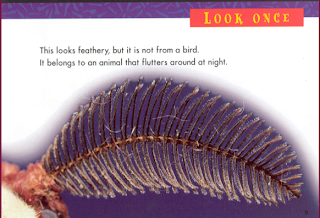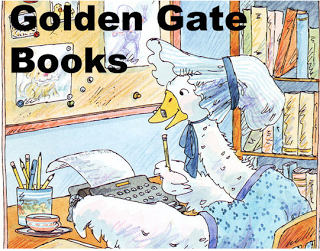I had just given an evening program for families at a school in Berkeley when a parent named Steven Birenbaum came up to tell me something remarkable. During the presentation I had introduced my book G Is for Googol: A Math Alphabet Book by projecting this inequality on the screen. (The slashed equal sign means “does not equal.”)
Category Archives: I.N.K
The Problem with Word Problems
Greetings from Lima, Peru. I’m here for a tour of three international schools (in Caracas, Lima and Santa Cruz, Bolivia). I had an experience in Caracas that I’ve had many times before in the USA and it has me thinking… and now blogging.
 On a screen, I showed a group of 2nd graders a page from one of my “Look Once, Look Again” books. The idea of that series is that you see a close-up photo of part of an animal (or plant) and text that hints about its identity. Then you turn the page to see the whole organism, and learn a bit about it.
On a screen, I showed a group of 2nd graders a page from one of my “Look Once, Look Again” books. The idea of that series is that you see a close-up photo of part of an animal (or plant) and text that hints about its identity. Then you turn the page to see the whole organism, and learn a bit about it.
Here’s the text: “This looks feathery but it is not from a bird. It belongs to an animal that flutters around at night.”
The Little Darlings
I was going to call this post “Kill the Little Darlings.” It sounded oh so ghastly that I decided to drop the first part, but killing them is what this is about. Don’t worry, I’m talking words, not people.
Years ago, someone told me that Somerset Maugham, the British novelist and playwright, had said, by way of advice to writers, “Murder the Little Darlings.” I’ve referred to this quote many times but always with the caveat that I have not able to confirm the source or the exact wording. Continue reading
Saguaro by the Numbers. Maybe
 I’m going to install a little window in my mind so you can see how it works. At least how it is working at this moment. It may not work in quite the same way at any future time. Here’s my promise: other than having decided on the overall idea, I have not planned the specifics of what I’m about to write. Instead, I will record my thought processes (if there are any) as they occur, to see if something interesting, useful or otherwise worthwhile happens. And if not, you’ll get to see that, too. Ready?
I’m going to install a little window in my mind so you can see how it works. At least how it is working at this moment. It may not work in quite the same way at any future time. Here’s my promise: other than having decided on the overall idea, I have not planned the specifics of what I’m about to write. Instead, I will record my thought processes (if there are any) as they occur, to see if something interesting, useful or otherwise worthwhile happens. And if not, you’ll get to see that, too. Ready?
Here’s the context. It happened earlier this month. I was in Phoenix for school visits, and I had a free afternoon so I went to the Desert Botanical Garden. Great place! Continue reading
New Hope for Old-Fashion Books
 Exactly one month ago I received an email from my friend and colleague (and fellow East Bay resident), Marissa Moss. It began almost apologetically:
Exactly one month ago I received an email from my friend and colleague (and fellow East Bay resident), Marissa Moss. It began almost apologetically:
“I know this probably comes out of thin air, but I’ve heard from so many talented writers and illustrators that they have problems getting contracts now from the major NY publishers who only want books with mass market appeal …”
Sounds like an understatement in these days of publishing uncertainty (aka “crisis”) but I was hooked. Marissa is a versatile writer and illustrator of both fiction and non-fiction, full of ambition and creativity, who has enjoyed considerable success. What was she up to?
“The golden age of picture books, when fine books were edited and published Continue reading
Got a Second
 You’d better use your extra second while you can, because it might just disappear.
You’d better use your extra second while you can, because it might just disappear.
I’m talking about the leap second. Leap seconds are a little like leap years but shorter. A lot shorter. (Actually, a “leap year” really should be called a “leap day,” IMHO.) And they are an endangered species.
It’ll take me just a few leap seconds to explain. Once upon a time, time itself was measured by the rotation of the earth. Continue reading
Numbers In the News
A few years ago I was greeted at a school by more than the usual “Welcome” banner. A bulletin board shouted, “Mr. Schwartz, We love BIG numbers, too!” Some of the numbers in articles from newspapers, magazines and websites had been highlighted, and children had written about the significance of the numbers in the context of the news items.
I appreciate it when a teacher guides students to the confluence of math and social studies where numbers and current events meet — which they do every day. Numbers are always in the news. Continue reading
Real World, Unreal School
When I walked into Masha Albrecht’s geometry class at Berkeley High School last week, her students were holding hands. It wasn’t budding romance. It was math. Before I explain, I have to tell you about Masha.
I met her when I was a senior at Cornell in the 1970s. I decided to do an independent study that involved working with students in an elementary school classroom and she was the most eager, bright-eyed fourth grader in the class. Masha’s brother Bobby was in an adjacent room and the two classes were team-taught. I hit it off with both siblings, and before the end of the semester I had been to their house several times, met their parents, and spent some enjoyable after-school hours together—doing math. The three of us had delved into Harold Jacobs’s masterful Mathematics: A Human Endeavor, then in its first edition, and we tackled the mind-stretching, often funny, problem sets with gusto. “This is how math should be taught in school,” exclaimed Mrs. Albrecht. Continue reading
Guest Blogger Marissa Moss: “Finding the Story in History”
This month I am taking a break from blogging. In my slot, I am proud to present my friend and collaborator (on G Is for Googol: A Math Alphabet Book), an esteemed author and illustrator of both fiction and non-fiction, Marissa Moss. You may be familiar with Marissa’s popular Amelia’s Notebook series or her other fictional series including Max Disaster and Daphne’s Diary. She is also the author of several highly-praised (and highly-researched) journal-style historical fiction novels and a half-dozen non-fiction biographical picture books telling the remarkable stories of remarkable women. Here, Marissa shares the backstory of the history she writes.
I love stumbling Continue reading
Lightweight Summertime Musings
Deer Mom and Dad…. whoops, wrong musing. That was my letter from camp when I was seven years old, in which I described my excitement at catching a “forg” in the pond.
This summer, just a few years after that incident, my summertime musings begin by recalling my final school visit tour of 2010-11, which took place in late May in rural Gallia County, Ohio. It’s in southeastern Ohio, near the charming small city of Gallipolis (pronounced nothing like Gallipoli, the peninsula in Turkey, but more like “Galley-Police”). This part of Ohio is in Appalachia, across the river from West Virginia, and just as scenic. Economically similar as well, I believe. I hadn’t realized Appalachia extends into Ohio. Continue reading


